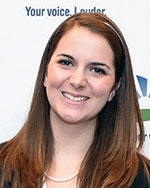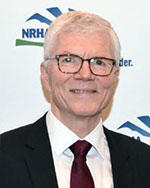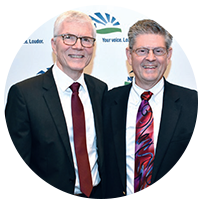Reimagining the role of physician assistants
Advanced practice providers vital to improving rural health
 Chandra Martin  Roger Wells |
Finding ways to tackle the physician shortage in rural America requires outside-the-box thinking, collaboration, and technology. For decades, rural communities have turned to advanced practice providers such as physician assistants (PAs) to fill the gaps in our health care system, and their role continues to evolve.
“Currently there’s a national shortage of almost 6,200 family practice physicians in rural areas,” says Roger Wells, PA-C. “Utilizing telemedicine solutions for supervision of and collaboration with advanced practice providers can help rural practices thrive and continue to serve smaller communities, even when a doctor can only be there one or two days a week.”
Wells has practiced at Howard County Medical Center in St. Paul, Neb., for the last 30 years. He was the recipient of NRHA’s 2018 President’s Award, selected by NRHA’s 2018 president Tommy Barnhart (see more below), and he has helped shape rural health policy by serving as a Centers for Medicare & Medicaid Services clinical champion at the Federal Office of Rural Health Policy.
Advanced practice providers like Wells bring value to rural health care in a number of ways, from cost control to improving patient care. Their training prepares them to be highly adaptable in various settings and specialties. PAs perform many of the same duties as physicians — they diagnose diseases, order tests, develop treatment plans, and write prescriptions, typically in collaboration with a group of physicians or under supervision of a physician. They also educate patients about prevention and lifestyle choices to improve health.
Wells believes there’s great potential for advanced practice providers to connect with patients on a personal level and understand the factors contributing to their overall health. “We typically have more time to spend with patients,” he explains. “As a result, we’re closely in tune with the day-to-day needs of patients and can bring those interventions into patient care. For example: Do they have transportation? Do they have a job? Do they have food and housing? Making improvements in these areas helps keep people healthy now and in the future.”
PAs then and now
In the mid-1960s, physicians and educators in the medical community recognized the shortage of primary care physicians. The PA profession was created to expand health care and fast-track those with medical experience into the field. “The first physician assistants were medics who had served in the military. They had advanced training and wanted to utilize those skills, and a physician assistant role was a great way for them to fill a growing need for primary care,” Wells says.
The need for PAs was highest in rural areas, where a single doctor often served one or more communities. “What happened in rural America is that many physicians were quickly overwhelmed and needed someone to assist them,” Wells explains. “Rather than bringing on another physician, they looked to PAs for help with daily tasks such as screening tests, help with an emergency call, or assistance during surgeries.”
In the early days, physician assistants mostly worked alongside doctors, serving as a second set of hands so doctors could be more efficient. “The job of the PA was mainly to function as an assistant to the doctor,” Wells says. “Now it’s more of a partnership or team practice, with PAs performing many of the same functions as a doctor and taking on more responsibilities.”
Today PAs practice under a supervising doctor and may consult about patients if needed, but they have the autonomy to see patients on their own, prescribe medications, and recommend treatment plans. “In rural areas, PAs wear even more hats — taking care of patients in a primary care or outpatient clinic as well as providing emergency services in a hospital,” Wells says. “About 30 to 40 percent of PAs work in primary care, including family practice, internal medicine, and pediatrics.”
The next generation of PAs
Students entering PA school often include experienced health care professionals, such as EMTs, paramedics, and nurses looking for a career change. Others are recent college graduates who completed pre-med coursework and weighed the options of attending PA school versus medical school.
Regardless of experience, many new students share a common desire for a fulfilling career with a realistic worklife balance. “Millennials have done a good job of drawing the line and recognizing that overextending yourself too much doesn’t pay in the long run,” Wells says. “They also have the ability to come in with a fresh perspective on ways to make things simpler by using technology and apps.”
Current PA student and former NRHA marketing and communications intern Chandra Martin wants to carve out her own path to a rewarding career. She received her bachelor of health sciences degree from the University of Missouri-Kansas City in 2018 and was accepted to the university’s master of medical science physician assistant program. She hails from a small town in Kansas and hopes to practice medicine in an underserved rural area. “Growing up, all I ever saw were PAs,” Martin says. “I rarely saw a doctor. The PAs did all the things that doctors do — the difference hardly even registered.”
Martin became interested in public health as an undergraduate, and she continued to explore the field through her NRHA internship. “Since my passion is rural health, working with NRHA was a great opportunity to learn about the concerns and challenges facing rural America,” Martin says. Shadowing a variety of health care providers including doctors, PAs, and pharmacists also helped Martin make a decision about applying for PA school. “At first I thought I wanted to be a pharmacist, but after spending time shadowing, I realized that I wanted to have a role with more direct interaction with patients,” Martin recalls.
She knew PA school would be competitive, but she kept her eyes on the prize. “I told myself, ‘It’s okay if I don’t get in the first time.’ I was already preparing how to strengthen my application for the next time when I found out I was accepted,” she says. “It’s all worth it, because you know you’ll have a job waiting after graduating from PA school.”
Career satisfaction off the charts
Aspects of the PA profession that Martin finds most attractive are related to career satisfaction. PAs have less student loan debt compared to doctors, quicker entry into the workforce, and greater flexibility with their careers. According to an American Academy of Physician Assistants survey, more than 96 percent of PAs would recommend the career to others. In U.S. News & World Report’s list of the best 100 jobs in 2018, physician assistant ranked third.
“PAs have the flexibility of being valuable at any market scenario,” Wells says. “They can shift directions from pediatrics to emergency care, for example, without having to go back to school. PAs don’t have as much burnout as doctors, and we don’t have to deal with many of the ancillary duties that doctors must handle, such as insurance, reimbursement, supervising, and staffing.” This can be attractive for someone who enjoys providing patient care without the added stress and logistics of running a practice. “One of my goals is to have a family,” Martin adds, “and be able to balance that with serving a small community.”
Forward-thinking solutions
Wells encourages students to think about their own values when considering a career in medicine. “Anyone going into these professions can be sure they will have a job now and in the future. There’s such a high need for providers, especially cost-effective providers, in this day and age when everyone is ratcheting down on costs,” Wells says. “As parents we often encourage kids to be doctors, lawyers, or senators. But that’s not for everybody, and we need leaders at every level. There are so many opportunities, and you shouldn’t feel pressured into shooting for a new galaxy when all you have to do is go to the moon. You can have a lot of career satisfaction in a mid-level career.”
The role of advanced practice providers continues to diversify in the changing landscape of health care, but its versatility lies in its simplicity. “The heart of my goal is to bring a valuable resource to an underserved area,” Martin says. “When you work with people over a long time and get to know them, you can see you’re making a difference.”
Tommy on Roger:
 Roger Wells (left) and NRHA President Tommy Barnhart |
It is my privilege, as NRHA president, to select a recipient for the President’s Award. This honor is given to a person who exemplifies the spirit of NRHA. My choice for the 2018 award is Roger D. Wells, PA-C.
Roger has been a physician assistant at Howard County Medical Center in St. Paul, Neb., since 1987. He has been active in NRHA since 2014. He has served on the Rural Health Congress and the Board of Trustees, and is currently chair of the Clinical Constituency Group. Roger has been instrumental in the development of many policies for NRHA, most recently the Physician Assistant Policy Paper.
In addition, Roger has assisted in policy development through the Federal Office of Rural Health Policy and was named a clinical champion for the Centers for Medicare & Medicaid Services.
Roger has served on numerous health panels, advisory committees, and commissions. This spirit of service is what makes Roger an ideal choice for the 2018 President’s Award. His work has affected rural populations on local, state, and national levels. He is an example of true servanthood as well as true leadership — a remarkable combination.
